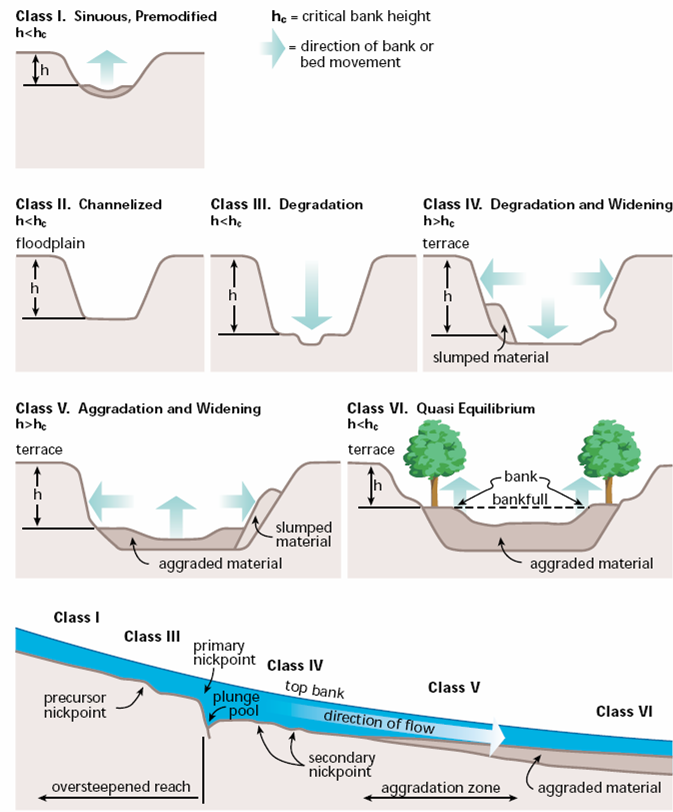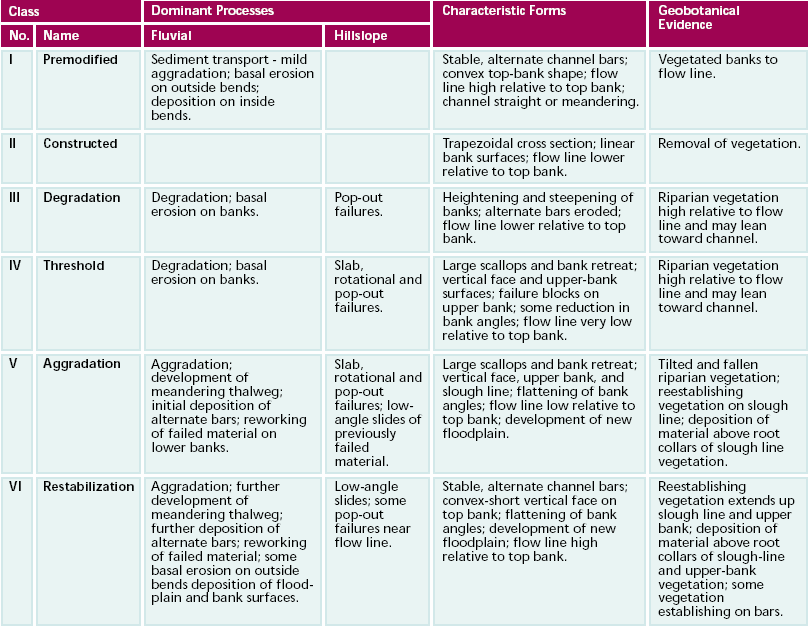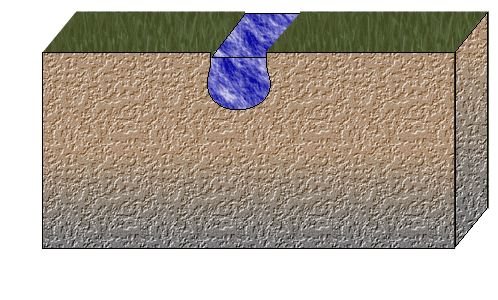Channel Evolution Models[1]
 Conceptual models
of channel evolution describe the sequence of changes a stream undergoes
after certain kinds of disturbances. The changes can include increases or
decreases in the width/depth ratio of the channel and also involve alterations
in the floodplain. The sequence of changes is somewhat predictable, so it is
important that the current stage (or “class”—see Figure) of evolution be
identified so appropriate actions can be planned. Schumm et al.
(1984), Harvey and Watson (1986), and Simon (1989) have proposed similar
channel evolution models due to bank collapse based on a “space-for-time” substitution,
whereby downstream conditions are interpreted as preceding (in time) the immediate
location of interest and upstream conditions are interpreted as following (in
time) the immediate location of interest. Thus, a reach in the middle of the
watershed that previously looked like the channel upstream will evolve to look
like the channel downstream. Downs (1995) reviews a number of classification
schemes for interpreting channel processes of lateral and vertical adjustment
(i.e., aggradation, degradation, bend migration, and bar formation). When these
adjustment processes are placed in a specific order of occurrence, a channel
evolution model (CEM) is developed.
Conceptual models
of channel evolution describe the sequence of changes a stream undergoes
after certain kinds of disturbances. The changes can include increases or
decreases in the width/depth ratio of the channel and also involve alterations
in the floodplain. The sequence of changes is somewhat predictable, so it is
important that the current stage (or “class”—see Figure) of evolution be
identified so appropriate actions can be planned. Schumm et al.
(1984), Harvey and Watson (1986), and Simon (1989) have proposed similar
channel evolution models due to bank collapse based on a “space-for-time” substitution,
whereby downstream conditions are interpreted as preceding (in time) the immediate
location of interest and upstream conditions are interpreted as following (in
time) the immediate location of interest. Thus, a reach in the middle of the
watershed that previously looked like the channel upstream will evolve to look
like the channel downstream. Downs (1995) reviews a number of classification
schemes for interpreting channel processes of lateral and vertical adjustment
(i.e., aggradation, degradation, bend migration, and bar formation). When these
adjustment processes are placed in a specific order of occurrence, a channel
evolution model (CEM) is developed.
Although a
number of CEMs have been suggested, two models (Schumm et al. 1984 and Simon
1989, 1995) have gained wide acceptance as being generally applicable for
channels with cohesive banks. Both models begin with a predisturbance
condition, in which the channel is well vegetated and has frequent interaction
with its floodplain. Following a perturbation in the system (e.g.,
channelization or change in land use), degradation occurs, usually as a result
of excess stream power in the disturbed reach. Channel degradation eventually
leads to oversteepening of the banks, and when critical bank heights are
exceeded, bank failures and mass wasting (the episodic downslope movement of
soil and rock) lead to channel widening. As channel widening and mass wasting
proceed upstream, an aggradation phase follows in which a new low-flow channel
begins to form in the sediment deposits. Upper banks may continue to be
unstable at this time. The final stage of evolution is the development of a
channel within the deposited alluvium with dimensions and capacity similar to
those of the predisturbance channel (Downs 1995). The new channel is usually
lower than the predisturbance channel, and the old floodplain now functions
primarily as a terrace. Once streambanks become high, either by downcutting or
by sediment deposition on the floodplain, they begin to fail due to a
combination of erosion at the base of the banks and mass wasting. The channel
continues to widen until flow depths do not reach the depths required to move the
sloughed bank materials. Sloughed materials at the base of the banks may begin
to be colonized by vegetation. This added roughness helps increase deposition
at the base of the banks, and a new small-capacity channel begins to form
between the stabilized sediment deposits. The final stage of channel evolution
results in a new bankfull channel and active floodplain at a new lower
elevation. The original floodplain has been abandoned due to channel incision
or excessive sediment deposition and is now termed a terrace. Schumm et al.
(1984) applied the basic concepts of channel evolution to the problem of
unstable channelized streams in Mississippi. Simon (1989) built on Schumm’s
work in a study of channelized streams in Tennessee. Simon’s CEM consisted of six
stages as shown in the drawing here. Both models use the cross section,
longitudinal profile, and geomorphic processes to distinguish stages of
evolution. Both models were developed for landscapes dominated by straightened,
channelized streams with cohesive banks. However, the same physical processes
of evolution can occur in streams with noncohesive banks but not necessarily in
the same well-defined stages. The table and figure below show the
processes at work in each of Simon’s stages.
Advantages of Channel Evolution Models
CEMs are useful in stream corridor restoration in the following ways (Note: Stages are from Simon’s 1989 six-stage CEM):
![]() CEMs help to establish the direction of
current trends in disturbed or constructed channels. For example, if a reach of
stream is classified as being in Stage IV of evolution, more stable reaches
should occur downstream and unstable reaches should occur upstream. Once
downcutting or incision occurs in a stream (Stage III), the headcut will
advance upstream until it reaches a resistant soil layer, the drainage area
becomes too small to generate erosive runoff, or the slope flattens to the
point that the stream cannot generate enough energy to downcut. Stages IV to VI
will follow the headcut upstream.
CEMs help to establish the direction of
current trends in disturbed or constructed channels. For example, if a reach of
stream is classified as being in Stage IV of evolution, more stable reaches
should occur downstream and unstable reaches should occur upstream. Once
downcutting or incision occurs in a stream (Stage III), the headcut will
advance upstream until it reaches a resistant soil layer, the drainage area
becomes too small to generate erosive runoff, or the slope flattens to the
point that the stream cannot generate enough energy to downcut. Stages IV to VI
will follow the headcut upstream.
![]() CEMs can help to prioritize restoration
activities if modification is planned. By stabilizing a reach of stream in
early Stage III with grade control measures, the potential degradation of that
reach and upstream reaches can be prevented. It also takes less intensive
efforts to successfully restore stream reaches in Stages V and VI than to
restore those in Stages III and IV.
CEMs can help to prioritize restoration
activities if modification is planned. By stabilizing a reach of stream in
early Stage III with grade control measures, the potential degradation of that
reach and upstream reaches can be prevented. It also takes less intensive
efforts to successfully restore stream reaches in Stages V and VI than to
restore those in Stages III and IV.
![]() CEMs can help match solutions to the problems.
Downcutting in Stage III occurs due to the greater capacity of the stream
created by construction, or earlier incision, in Stage II. The downcutting in
Stage III requires treatments such as grade control aimed at modifying the
factors causing the bottom instability. Bank stability problems are dominant in
Stages IV and V, so the approaches to stabilization required are different from
those for Stage III. Stages I and VI typically require only maintenance
activities.
CEMs can help match solutions to the problems.
Downcutting in Stage III occurs due to the greater capacity of the stream
created by construction, or earlier incision, in Stage II. The downcutting in
Stage III requires treatments such as grade control aimed at modifying the
factors causing the bottom instability. Bank stability problems are dominant in
Stages IV and V, so the approaches to stabilization required are different from
those for Stage III. Stages I and VI typically require only maintenance
activities.
![]() CEMs can help provide goals or models for
restoration. Reaches of streams in Stages I and VI are graded streams, and
their profile, form, and pattern can be used as models for restoring unstable
reaches.
CEMs can help provide goals or models for
restoration. Reaches of streams in Stages I and VI are graded streams, and
their profile, form, and pattern can be used as models for restoring unstable
reaches.
Limitations of Channel Evolution Models
The chief
limitations in using CEMs for stream restoration are as follows:
![]() Future changes in base level elevations and
watershed water and sediment yield are not considered when predicting channel
response.
Future changes in base level elevations and
watershed water and sediment yield are not considered when predicting channel
response.
![]() Multiple, simultaneous adjustments by the
stream are difficult to predict.
Multiple, simultaneous adjustments by the
stream are difficult to predict. 
References
![]() Schumm, S. A.,
Harvey, M. D., and Watson, C. C. (1984). Incised channels: morphology, dynamics
and control. Water Resources Publications, Littleton,
Schumm, S. A.,
Harvey, M. D., and Watson, C. C. (1984). Incised channels: morphology, dynamics
and control. Water Resources Publications, Littleton, CO.Colo.
![]() Simon, A.
(1989). “The discharge of sediment in channelized alluvial streams.” Water
Resources Bulletin, 25(6), 1177-1188.
Simon, A.
(1989). “The discharge of sediment in channelized alluvial streams.” Water
Resources Bulletin, 25(6), 1177-1188.

Animated CEM image provided by: SUNY ESF